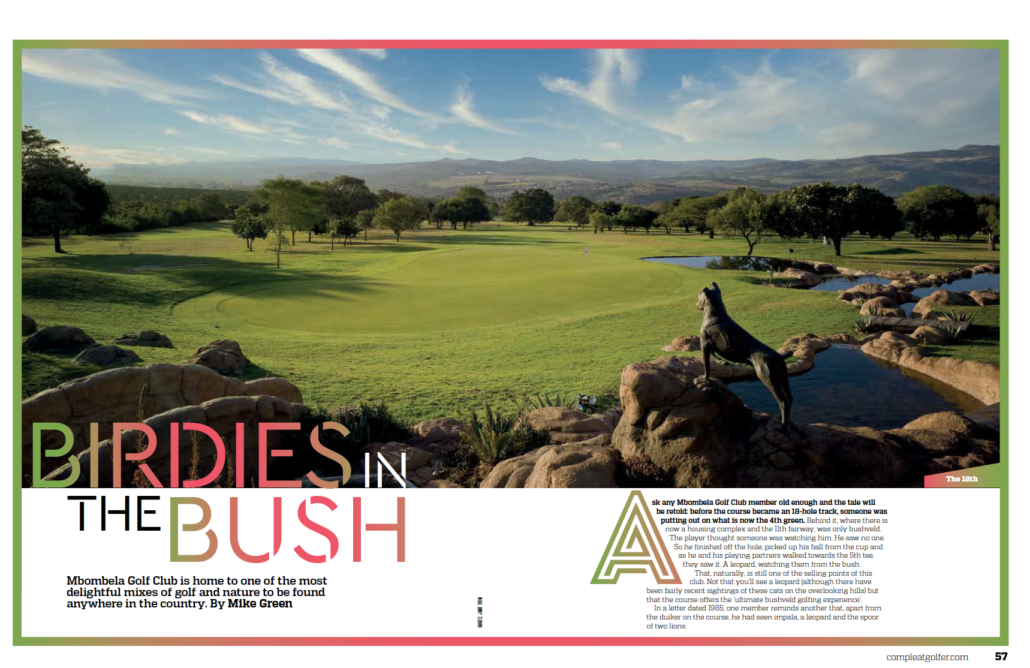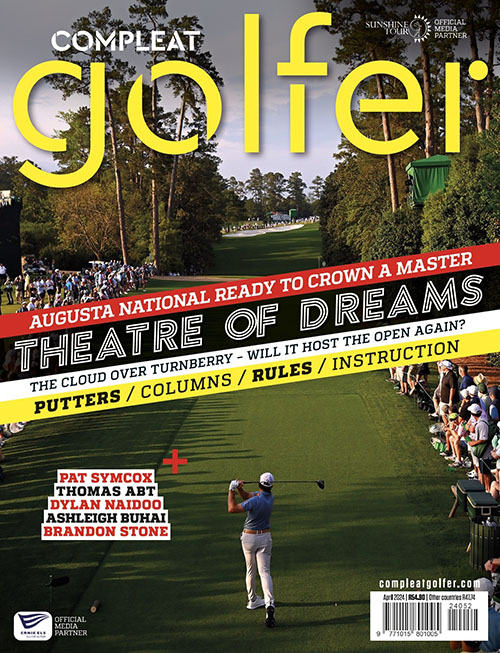Mbombela Golf Club is home to one of the most delightful mixes of golf and nature to be found anywhere in the country, writes MIKE GREEN.
Ask any Mbombela Golf Club member old enough and the tale will be retold: before the course became an 18-hole track, someone was putting out on what is now the 4th green. Behind it, where there is now a housing complex and the 11th fairway, was only bushveld. The player thought someone was watching him. He saw no one. So he finished off the hole, picked up his ball from the cup and as he and his playing partners walked towards the 5th tee, they saw it. A leopard, watching them from the bush.
That, naturally, is still one of the selling points of this club. Not that you’ll see a leopard (although there have been fairly recent sightings of these cats on the overlooking hills) but that the course offers the ‘ultimate bushveld golfing experience’.
In a letter dated 1985, one member reminds another that, apart from the duiker on the course, he had seen impala, a leopard and the spoor of two lions.
The days of the big five are long gone, but the dwarf mongoose are delightful, and late-afternoon rounds are often enlivened by the scurrying of a large family heading to their sleeping place at a favoured termite mound behind the 15th.
The course is home to an incredible array of animals and birds, and you get the feeling that at any given time you will be fortunate enough to spot some of the wildlife, from the small red and grey duiker and klipspringers to any of the 250 species of birds. Charmingly, the abundance of white-fronted bee-eaters sometimes leads to bunkers being declared out of play as the beautiful and gregarious birds nest in them. Golfers should also be aware that the course is home to some venomous snakes.
Nelspruit Golf Club changed its name to Mbombela Golf Club in August 2017 as part of a transformation and development programme which embraced the African name of the town.
In the time of the coronavirus pandemic and its attendant isolation, the club was one of the first to announce assistance for its caddies. Through the efforts of most members and the caddie trust, they were able to provide each of the caddies with a R1 200 grant as well as some basic groceries.
The club is famous for hosting the annual Jock of the Bushveld Festival of Golf, considered the biggest amateur tournament of its kind in the world. Started in 1968, the event has grown to the extent where some 800 amateurs from far and wide play more than 2 000 rounds during a week in May.
The design of the layout, set among rocky outcrops typical of the area, has a long and storied history. The original course was laid out in 1928 but the club relocated to its current spot in 1939, when the leading golf course architect of the time, Bob Grimsdell, put together a solid nine-holer.
An amusing aside about Grimsdell: he sent his plans and his greenkeeper from Johannesburg, as well as his account for £37.10. The Village Council met to approve the account for payment and Andy Drysdale (father of tennis player Cliff) said it was ridiculous. No one was worth £12.10 per day and the amount for three days should be cut to £12.10. Grimsdell got to hear of this and swore never to set foot in Nelspruit again – even though the council did pay his full account.
Almost 30 years later Grimsdell did return to complete the job, adding the other nine holes and, in so doing, transformed the course into a challenging 18-hole championship layout that most recently hosted the 2019 Golf RSA Inter-Provincial Tournament.
In typical Grimsdell style, the result was a course that consisted of 18 strong holes flowing seamlessly from one to the next, with no obvious weaknesses. Even today, it is difficult to pinpoint a signature hole on the Mbombela layout – and even more difficult to select a poor hole.
Peter Matkovich was the next designer to apply his magic touch to the golf course, in 1998, when he created the first three holes and redesigned all the greens as part of the club’s evolution to become part of the Matumi Golf Estate, a Johnnic development. The company agreed to renovate the clubhouse, construct 18 new bent-grass greens and install new bunkers.
At around 6 000m in length, Mbombela is relatively short by modern standards and the fairways are reasonably generous. Yet, for players to take advantage of the scoring opportunities that present themselves, they need to successfully navigate the imposing indigenous trees that line the fairways and restrict the shot options for
the player who is out of position.
The impressive view from the balcony of the clubhouse sweeps across to the hills beyond the wide Crocodile River valley. Further north, distant mountain peaks shimmer in the heat haze of the Lowveld.
The golf course, which gently drops away from the clubhouse into the valley, may at first glance appear a relatively easy-going, classical parkland layout. However, the long and tough opening par four (stroke one) and downhill par-five 2nd should correct any thoughts you may have had of a record-breaking score.
Those early front nine holes and all the back nine present a variety of challenges, including some occasionally tight tee shots and approaches, wonderful carries over ravines at the par threes and plenty of changes in elevation. Only the closing section of the front nine features that rather classical, gently sloping parkland you see from the clubhouse.
Among many excellent golf holes, the par-three 5th is a gem, requiring an accurate carry over a wide ravine, with the river below. The plunging par-five 14th, played from an elevated tee, is another dramatic and potentially card-wrecking hole. A good drive over the estate’s entrance road will set up a possible birdie for the longer hitters, provided they keep clear of the trees on the left and the ravine on the right. Playing safe will allow you to lay up past the marula trees on either side of the fairway. Stay out of the bunkers left and right of the green and par is yours.
While the 509m 2nd hole asks tough questions off the tee, the remaining par fives present excellent scoring opportunities for even the medium-length hitters.
The 445m 4th hole has its fairway bisected by a red penalty area which is out of sight from the tee and the unwary longer drivers could end up in it. After that, the fairway is cradled by bounce-friendly slopes on either side which help keep you straight before the deep, elevated green awaits you.
Equally, the course has a number of short par fours, including a stretch of four in a row around the turn, which should give players a decent chance of birdie. The 8th at 342m is relatively straight and simple. It requires an accurate tee shot to the right side of the fairway, and then you need to check the pin position on the two-tiered green before playing your approach.
The 9th plays 316m from the back and the average golfer will be playing a relatively short pitch to another two-tiered green. Again, being on the right of the fairway is ideal, with a large Natal mahogany tree guarding the left side. Just watch out for the small pond on the right of the green.
The back nine starts with the frustratingly challenging 355m par four, where the slope of the fairway takes slightly errant drives to the right. If you end up too far down and too far right, a large marula tree will block your approach.
The 11th, at just 297m, tees off over an irrigation dam where you will often see hamerkops around the edges. Longer hitters can find the front of the large putting surface, but an iron off the tee sets up a short pitch and a birdie opportunity.
Mbombela also has an excellent mix of par threes, with the 210m 3rd the most challenging of the quartet, but even the shorter 5th and 17th holes require precise tee shots over a ravine to a small target.
The 3rd has a bunker guarding the left side of the green with the ground sloping away from the green to the right. So if you do bail out right – and that’s the most likely outcome – you are often left with a teasingly difficult chip to get close to the pin.
The 141m 5th requires a shot over a donga (and don’t bother looking for your ball if you’re short) that steers clear of the three bunkers lying in wait on the right of the green and of the slope away to the early part of the 4th fairway to the left.
And the very short – 121m – 17th over the edge of the irrigation dam and the donga is a scenic gem. Don’t be fooled if the pin position is tight left, because a ball down into the donga is gone forever. Hit your ball to the middle of the green, take your par and head for home.
The closing hole, a long par four of 384m, ensures golfers have earned their post-round drinks. A large sycamore fig tree, reputed to be over 200 years old, on the left-hand side just before the fairway demands accuracy as it will catch any drive pulled or hooked slightly left. And with a younger and smaller tree on the right, you either have to thread the needle or go over the tree on the right-hand side to find the fairway.







